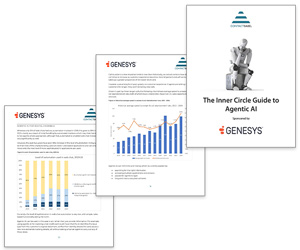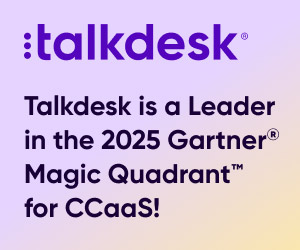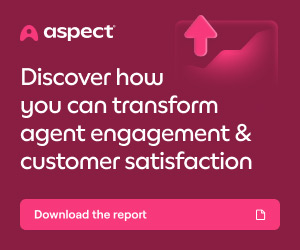Joe Partridge-Jones at Genesys explores how organisations can move beyond tactical AI deployments to build truly transformative customer experience strategies that start with leadership vision and end in measurable business growth.
AI should no longer be treated as a tactical tool for process improvement. To unlock its full potential, organisations must adopt a transformative mindset, starting with strategic goals at the top and reverse-engineering their customer experience operating model with AI as the cornerstone.
Too often, organisations view AI tactically: a chatbot here, a virtual assistant there, some automated workflows to shave costs. These efforts may create efficiencies, but they rarely drive true differentiation.
The transformative potential of AI lies in reimagining the business itself. That requires starting at the top. Leadership teams must first define the strategic goals of the organisation:
- Do we want to increase customer lifetime value?
- Do we want to reduce churn and protect margins?
- Do we want to expand into new markets or segments?
Once those goals are clear, organisations can reverse-engineer their strategy: designing every process, team structure, and technology decision with AI as the enabler. For example:
- If the goal is retention, AI can predict churn signals and trigger proactive interventions.
- If the goal is growth, AI can identify cross-sell opportunities and personalise recommendations.
- If the goal is employee engagement, AI can automate low-value work and empower staff with insights.
This shift requires moving from a tactile mindset, focused on short-term efficiency gains, to a transformative mindset where AI is embedded into the DNA of the organisation. It’s not about adding AI to existing processes; it’s about rebuilding processes around AI to achieve strategic goals.
Cross-Industry examples:
1. Banking & Financial Services – From Transactions to Trusted Guidance
A leading European bank redefined its customer engagement by embedding AI into its strategy. Instead of just using chatbots for FAQs, the bank used AI to anticipate customer needs, such as predicting when a customer might need credit support, investment advice, or fraud detection.
Outcomes:
- 20% reduction in churn by proactively engaging at-risk customers.
- Increased cross-sell and upsell opportunities through AI-driven product recommendations.
- Stronger customer trust, shifting perception of the bank from a transactional provider to a financial partner.
Transformation vs. Tactical: Instead of deploying AI to cut call volumes, the bank restructured its operating model around AI-enabled proactive experiences.
2. Retail – From Discounts to Personalised Journeys
A global retailer placed AI at the core of its CX strategy by building a unified customer data platform. AI stitched together data across online, in-store, and mobile touchpoints to provide a single view of the customer.
Outcomes:
- Personalised product recommendations increased basket size by 15%.
- Predictive inventory management reduced stockouts and improved fulfilment speed.
- Customer satisfaction rose as buyers received relevant offers and faster delivery.
Transformation vs. Tactical: Instead of just adding a “recommendation engine” to the e-commerce site, the retailer rebuilt its customer journey orchestration around AI insights.
3. Telecom – From Call Centres to Predictive Care
A large telecom operator shifted its CX model from reactive service to predictive care. AI monitored customer usage patterns, network data, and billing issues to predict service disruptions or dissatisfaction before customers called in.
Outcomes:
- 25% drop in inbound support calls.
- Faster issue resolution, with many problems fixed before the customer even noticed.
- Improved loyalty scores and reduced churn in a highly competitive market.
Transformation vs. Tactical: Rather than just automating agent responses, AI was integrated into network operations and CX strategy to deliver proactive care.
4. Healthcare – From Appointments to Preventive Care
A healthcare provider embedded AI into its overall strategy by combining CX data with clinical data. AI helped identify patients at risk of chronic conditions and enabled proactive engagement through digital channels.
Outcomes:
- Improved patient outcomes with earlier interventions.
- Increased patient satisfaction as engagement became more personalised and convenient.
- Optimised resource allocation, reducing unnecessary appointments and hospitalisations.
Transformation vs. Tactical: Instead of deploying AI only for virtual assistants, the organisation redesigned care pathways around predictive insights.
5. Travel & Hospitality – From Service Recovery to Anticipatory Experience
A global hotel chain adopted AI as a central pillar of its guest experience strategy. AI analysed guest behaviour, preferences, and past stays to anticipate needs (room type, dietary restrictions, leisure activities) and provide tailored offers before and during travel.
Outcomes:
- Guest satisfaction scores improved by 30%.
- Repeat bookings grew significantly, as AI-driven personalisation deepened loyalty.
- Operational efficiency increased by predicting peak demand and optimising staffing.
Transformation vs. Tactical: Instead of automating check-in kiosks, the chain re-engineered the guest journey to be AI-first, focusing on emotional connection and loyalty.
Patterns in True Transformation
Across these industries, the common threads are:
True transformation happens when AI becomes the engine of differentiation and growth, not just a cost-saving tool.
Benefits of adopting change:
- CX evolves from a cost centre to a growth driver, fully aligned with enterprise ambitions.
- Employees are empowered to deliver more value, supported by AI insights.
- The organisation gains a sustainable competitive advantage, with AI embedded into its operating model.
Consequences of standing still: Treating AI as a tactical afterthought will leave organisations stuck in incremental improvements while competitors leap ahead with transformational innovation.
Customers will gravitate to brands that anticipate their needs, employees will seek workplaces where they feel empowered, and laggards will face declining relevance and market share.
In the AI era, transformation is not optional. It’s the only way forward. Organisations that lead with vision, start with strategy, and put AI at the core will shape the future. Those who don’t will be left chasing it.
This blog post has been re-published by kind permission of Genesys – View the Original Article
For more information about Genesys - visit the Genesys Website
Call Centre Helper is not responsible for the content of these guest blog posts. The opinions expressed in this article are those of the author, and do not necessarily reflect those of Call Centre Helper.
Author: Genesys
Reviewed by: Rachael Trickey
Published On: 4th Nov 2025
Read more about - Guest Blogs, Genesys






 Genesys empowers more than 8,000 organisations in over 100 countries to improve loyalty and business outcomes by creating the best experiences for their customers and employees. Through Genesys Cloud, the AI-Powered Experience Orchestration platform, Genesys delivers the future of CX to organisations of all sizes so they can provide empathetic, personalised experience at scale. As the trusted platform that is born in the cloud, Genesys Cloud helps organisations accelerate growth by enabling them to differentiate with the right customer experience at the right time, while driving stronger workforce engagement, efficiency and operational improvements.
Genesys empowers more than 8,000 organisations in over 100 countries to improve loyalty and business outcomes by creating the best experiences for their customers and employees. Through Genesys Cloud, the AI-Powered Experience Orchestration platform, Genesys delivers the future of CX to organisations of all sizes so they can provide empathetic, personalised experience at scale. As the trusted platform that is born in the cloud, Genesys Cloud helps organisations accelerate growth by enabling them to differentiate with the right customer experience at the right time, while driving stronger workforce engagement, efficiency and operational improvements. 


































